Williams 3518232, 3538232, 3558232, 3508632, 3518632 User Manual
...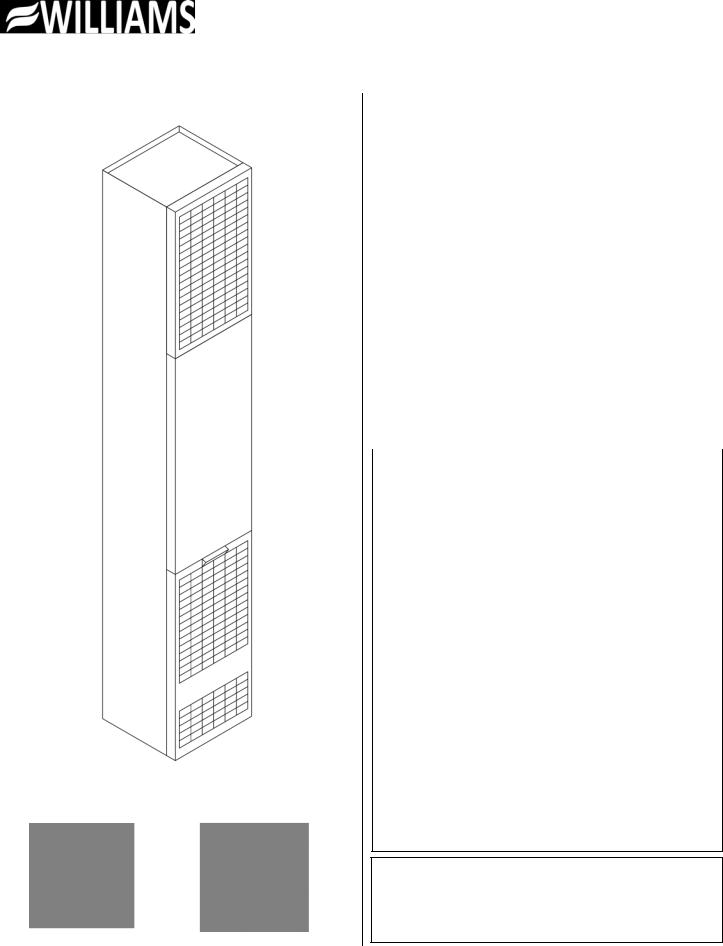
|
|
|
|
|
|
|
|
Owner’s Manual |
|
Save this manual for future reference. |
|||
|
|
|
|
|
||
|
|
|
Forsaire Counterflow |
|||
|
|
|
|
Top-Vent Gas Wall |
||
|
|
|
|
|
Furnaces |
|
|
Model Numbers: |
|
|
|||
3508232; 3518232; 3538232; 3558232; 3508632; 3518632; |
|
|||||
3538632; 3558632; 5008632; 5018632; 5038632; 5058632; |
|
|||||
5508232; 5518232; 5538232; 5558232; 6508632; 6518632; |
|
|||||
6538632; |
6558632 |
|
|
|||
|
FOR USE WITH NATURAL GAS ONLY |
|||||
|
Model Numbers: |
|
|
|||
3508231; 3518231; 3538231; 3558231; 3508631; 3518631; |
|
|||||
3538631; 3558631; 5008631; 5018631; 5038631; 5058631; |
|
|||||
5508231; 5518231; 5538231; 5558231; 6508631; 6518631; |
|
|||||
6538631; 6558631 |
|
|
||||
|
FOR USE WITH PROPANE GAS ONLY |
|||||
|
READ THIS OWNER’S MANUAL CAREFULLY BEFORE YOU |
|||||
|
INSTALL YOUR NEW WILLIAMS WALL FURNACE. |
|||||
|
|
|
|
|
|
|
|
|
|
|
|
|
|
|
|
|
WARNING: |
If the information in these |
|
|
|
|
|
instructions is not followed exactly, a fire or |
|
||
|
|
|
explosion may result causing property |
|
||
|
|
|
damage, personal injury or loss of life. |
|
||
|
|
Do not store or use gasoline or other |
||||
|
|
|
flammable vapors and liquids in the vicinity |
|||
|
|
|
of this or any other appliance. |
|||
WHAT TO DO IF YOU SMELL GAS:
• Open all windows.
• Do not try to light any appliance.
• Do not touch any electrical switch; do not use any phone or cell phone in your building.
• Extinguish any open flame.
• Immediately call your gas supplier from a neighbor’s phone. Follow the gas supplier’s instructions.
• If you cannot reach the gas supplier, call the fire department.
Installation and service must be performed by a qualified installer, service agency or the gas supplier.
WARNING: Improper installation, adjustment, alteration, service or maintenance can cause injury or property damage. Refer to this manual. For assistance or for additional information consult a qualified installer, service agency or the gas supplier.
|
|
Williams Furnace Co. |
250 West Laurel Street Colton, California 92324 U.S.A. |

Warranty & Installation Record – 2
Warranty
The manufacturer, Williams Furnace Co., warrants this wall furnace or heater to the original purchaser under the following conditions:
LIMITED ONE-YEAR WARRANTY
1.Any part thereof which proves to be defective in material or workmanship within one year from date of original purchase for use will be replaced at the Manufacturer’s option, FOB to its factory.
2.No liability is assumed by the Manufacturer for removal or installation labor costs, nor for freight or delivery charges.
LIMITED EXTENDED WARRANTY
1.In addition to the above limited one-year warranty on the complete unit, any combustion chamber which burns out or rusts under normal installation, use and service conditions during a period of nine years following expiration of the one-year warranty period will be exchanged for a like or functionally similar part.
2.No liability is assumed by the Manufacturer for removal or installation labor costs, nor for freight or delivery charges.
LIMITATIONS
1.THIS LIMITED WARRANTY IS THE ONLY WARRANTY MADE BY THE MANUFACTURER, IMPLIED WARRANTIES OF MERCHANTABILITY OR FITNESS FOR ANY PARTICULAR PURPOSE ARE LIMITED TO THE SAME ONE YEAR TERM AS THE EXPRESS WARRANTY. UNDER NO CIRCUMSTANCES SHALL THE MANUFACTURER BE LIABLE FOR INCIDENTAL, CONSEQUENTIAL, SPECIAL OR CONTINGENT DAMAGES OR EXPENSES ARISING DIRECTLY OR INDIRECTLY FROM ANY DEFECT IN THE PRODUCT OR ANY COMPONENT OR FROM THE USE THEREOF. THE REMEDIES SET FORTH HEREIN ARE THE EXCLUSIVE REMEDIES AVAILABLE TO THE USER AND ARE IN LIEU OF ALL OTHER REMEDIES.
Some states do not allow limitation on how long an implied warranty lasts, and some states do not allow the exclusion or limitation of incidental or consequential damages, so the above limitations or exclusions may not apply to you.
2.This warranty does not include any charge for labor or installation.
3.This warranty does not extend to painted surfaces or to damage or defects resulting from accident, alteration, misuses or abuse or improper installation.
4.This warranty does not cover claims which do not involve defective workmanship or materials.
DUTIES OF THE CONSUMER
1.The heating equipment must be installed by a qualified installer and operated in accordance with the installation and homeowner’s instructions furnished with the equipment.
2.Any travel, diagnostic costs, service labor, and labor to repair the defective unit will be the responsibility of the owner.
3.A bill of sale, cancelled check, payment record or permit should be kept to verify purchase date to establish the warranty period.
4.Have the installer enter the requested information in the space below.
GENERAL
1.The manufacturer neither assumes nor authorizes any person to assume for it any other obligation or liability in connection with said equipment.
2.Service under this warranty should be obtained by contacting your dealer. Provide the dealer with the model number, serial number, and purchase date verification.
3.If, within a reasonable time after contacting your dealer, satisfactory service has not been received, contact: Customer Service Department, 250 West Laurel Street, Colton, CA 92324 for assistance.
4.THIS WARRANTY GIVES YOU SPECIFIC LEGAL RIGHTS AND YOU MAY ALSO HAVE OTHER RIGHTS WHICH VARY FROM STATE TO STATE.
Installation Record
Model No. ______________________________________________________________ Serial No. ___________________________
Original Purchaser____________________________________________________________________________________________
Address ____________________________________________________________________________________________________
City and State ___________________________________________________________ Zip ________________________________
Dealer _____________________________________________________________________________________________________
Address ____________________________________________________________________________________________________
City and State ___________________________________________________________ Zip ________________________________
Installation Date_______________ Name ________________________________ Signature_________________________________
(Dealer or authorized representative who certifies that this appliance is installed in accordance with Manufacturer’s instructions and local codes.)
2
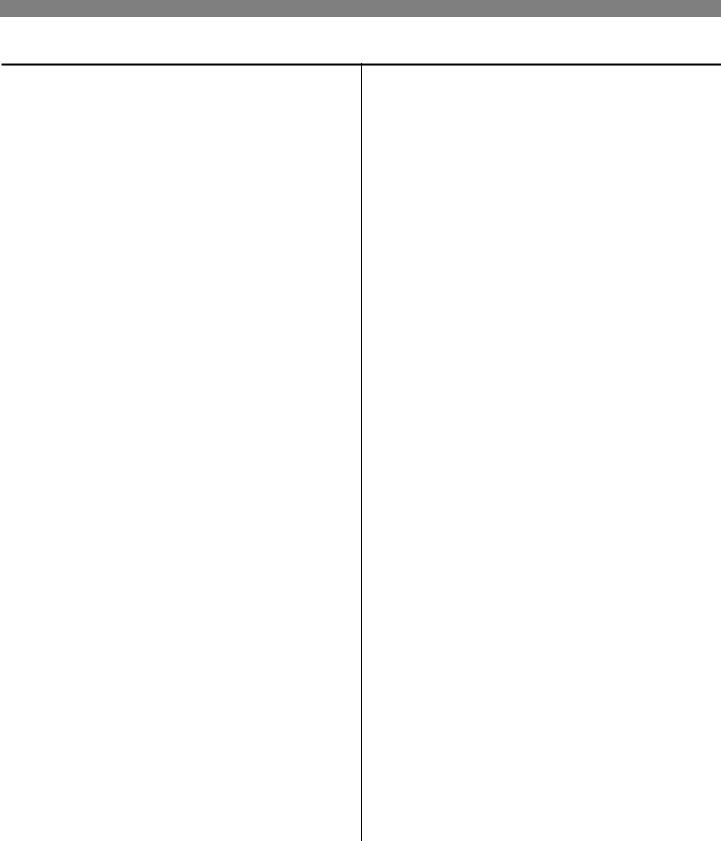
Contents
Your Williams Warranty................................................................. |
2 |
Installation Record......................................................................... |
2 |
Table of Contents .......................................................................... |
3 |
Safety Rules.................................................................................. |
4 |
Introduction.................................................................................... |
5 |
Basic Description........................................................................... |
5 |
Basic Tools Needed ...................................................................... |
5 |
Basic Materials Needed................................................................. |
5 |
Optional Accessories..................................................................... |
6 |
Installing Your Wall Furnace.......................................................... |
7 |
Locating Wall Furnace and Thermostat..................................... |
7-8 |
Combustion and Ventilation Air ............................................... |
8-11 |
Installation |
|
Recessed Mount Installation........................................ |
11-13 |
Surface Mount Installation ........................................... |
13-14 |
General Vent Installation.............................................. |
14-16 |
Mounting Your Furnace......................................................... |
16-17 |
Gas Supply and Piping.......................................................... |
18-19 |
Electrical Wiring........................................................................... |
19 |
Thermostat Installation ................................................................ |
20 |
Start Up Procedure...................................................................... |
21 |
Operating Your Furnace........................................................ |
22-23 |
How To Care For Your Furnace ............................................ |
24-25 |
Furnace Technical Information.................................................... |
26 |
TROUBLESHOOTING CHART ............................................. |
27-29 |
Wiring Diagrams.................................................................... |
30-31 |
Repair Parts .......................................................................... |
32-35 |
Repair Parts List.................................................................... |
36-39 |
Forsaire Hardwire Accessary - 9940 ........................................... |
40 |
Service Record...................................................................... |
41-43 |
SERVICE HINTS.......................................................... |
Back Cover |
How To Order Repair Parts.......................................... |
Back Cover |
Quick Reference: Here’s how to… |
|
Unpack the furnace....................................................................... |
6 |
Learn how to unpack the new Williams Furnace and verify that all |
|
its parts are in working order. |
|
Install the furnace..................................................................... |
7-21 |
Recessed Mount, Surface Mount, and Vent Installation is all |
|
explained starting on page 11. |
|
Operate the furnace............................................................... |
22-23 |
Igniting the furnace for the first time. |
|
Caring for Your Furnace ........................................................ |
24-25 |
Learn how to keep your new Williams Furnace operating. |
|

Safety Rules
WARNING: Read these rules and the instructions carefully. Failure to follow these rules and instructions could cause a malfunction of the furnace. This could result in death, serious bodily injury and/or property damage.
INSTALLATION MUST CONFORM TO LOCAL CODES. IN THE ABSENCE OF LOCAL CODES, INSTALLATION MUST CONFORM TO THE NATIONAL FUEL GAS CODE, ANSI Z223.1. THE APPLIANCE, WHEN INSTALLED MUST BE ELECTRICALLY CONNECTED AND GROUNDED IN ACCORDANCE WITH LOCAL CODES OR, IN THE ABSENCE OF LOCAL CODES, WITH THE CURRENT NATIONAL ELECTRICAL CODE ANSI/NFPA NO. 70.
In Canada:
1.Installation must conform to local codes or, in the absence of local codes, the current CAN/CGA B149 installation code.
2.The appliance, when installed, must be electrically connected and grounded in accordance with local codes or, in the absence of local codes, with the current CSA C22.1 Canadian Electrical code.
3.Field conversions for high altitude are not permitted in Canada.
4.Reference is made in this manual regarding gas type as L.P.G. Be advised that L.P.G. is not available in Canada, refer to propane/L.P. Gas.
1.Use only manufacturer's replacement parts. Use of any other parts could cause injury or death.
2.DO NOT install the furnace in an alcove.
3.DO NOT install this furnace where it could be isolated by closing doors to the heated space.
4.DO NOT install this furnace in a travel trailer or recreational vehicle.
5.MAINTAIN all clearances specified in section "Locating Wall Furnace and Thermostat" and "Vent Installation."
6.BE SURE this furnace is for type of gas to be used. Check the rating plate by the gas valve in the lower cabinet. Do not change it to use other gases without the proper manufacturer’s Gas Conversion Kit.
7.For natural gas, the minimum inlet gas supply pressure for the purpose of input adjustment is 5" water column. The maximum inlet gas supply pressure is 7" water column.
For L.P. Gas, the minimum inlet gas supply pressure for the purpose of input adjustment is 11" water column. The maximum inlet gas supply pressure is 13" water column.
8.Any safety screen, guard or parts removed for servicing this appliance must be replaced prior to operating the appliance to avoid property damage, bodily injury or death.
4
9.Install the furnace vent directly to the outdoors so that harmful combustible flue gases will not collect inside the building. Follow the venting instructions for your type of installation exactly. Use only the type and size of vent pipe and fittings specified.
10.BE SURE to provide for adequate combustion and ventilation air. The flow of this air to the furnace must not be blocked.
11.NEVER vent flue gases into another room, a fireplace or any space inside a building. This could cause property damage, bodily injury or death.
12.Never test for gas teaks with an open flame. Use a soap solution to check all gas connections. This will avoid the possibility of fire or explosion.
13.ALLOW the furnace to cool before servicing. Always shut off electricity and gas to furnace when working on it. This will prevent any electrical shocks or burns.
14.DUE TO HIGH TEMPERATURES, locate the furnace out of traffic and away from furniture and draperies.
15.ALERT children and adults to the hazards of high surface temperatures and warn them to keep away to avoid burns or clothing ignition.
16.CAREFULLY supervise young children when they are in the same room with the furnace.
17.DO NOT place clothing or other flammable material on or near furnace.
18.INSTALLATION and REPAIR must be done by a qualified service person. The appliance should be inspected before use and at least annually by a professional service person. More frequent cleaning may be required due to excessive lint from carpeting, bedding material, etc. It is imperative that control compartments, burners and circulating air passages be kept clean.
19.BEFORE INSTALLING: To avoid electrical shock, tum off electrical circuits that pass through the wall where you are going to install the furnace.
20.BE AWARE of good safety practices by wearing personal protective equipment such as gloves and safety glasses to avoid being injured by sharp metal edges in or around furnace and while cutting or drilling holes in wood and/or sheet metal.
21.CAUTION: Label all wires prior to disconnection when servicing controls.
WARNING: Do not use this furnace if any part has been under water. Immediately call a certified service technician to inspect the furnace and to replace any part of the control system and any gas control which has been under water.
WARNING: Do not install any of these furnaces (Natural or L.P. Gas) in mobile homes, trucks or recreational vehicles.
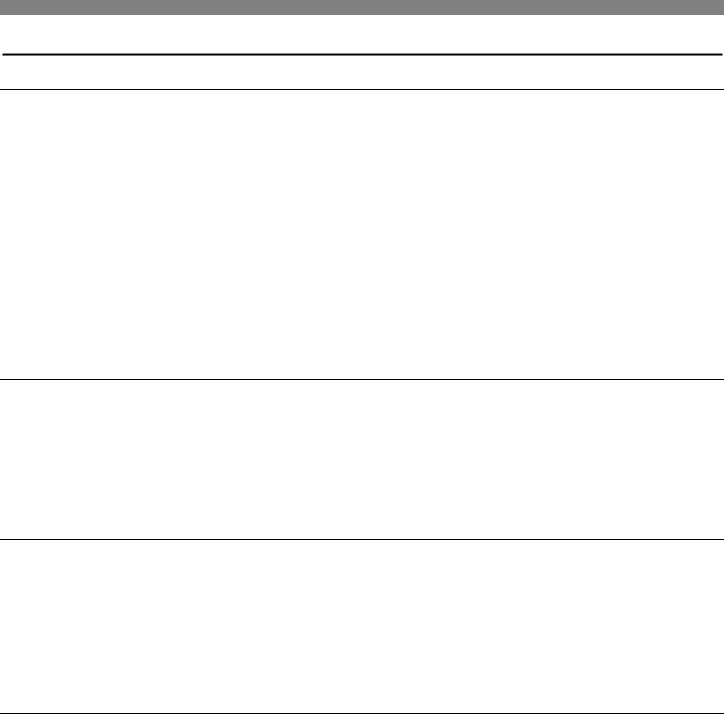
Introduction – 5
Introduction
Basic Description
The following steps are all needed for proper installation and safe operation of your furnace. If you have any doubts as to any requirements, check with local authorities. Obtain professional help where needed. All of the checks and adjustments in the “Start-Up Procedures” are vital to the proper and safe operation of your furnace. Please read our instructions before you install and use your furnace. This will help you obtain the full value from this furnace. It could also help you avoid needless service costs if the answer to the problem is found within this instruction manual.
Always consult your local heating or plumbing inspector, building department or gas utility company regarding regulations, codes or ordinances which apply to the installation of a counterflow top vented wall furnace.
Check the furnace nameplate, located in the burner compartment, to make sure the furnace is equipped to operate on the type of gas available (either natural or L.P. gas).
DO NOT convert the furnace from natural gas to L.P. gas or from L.P. gas to natural gas without the proper manufacturer’s gas conversion kit.
Your Counterflow Top Vent Furnace draws air in at the top of the furnace by the fan and discharged through the grille near the floor. It is shipped ready to install on the surface of a wall or recessed into a wall. Combustion air is drawn in from the room where the furnace is located and vented out the top of the furnace through listed vent piping to a roof top vent. Venting material is not supplied with this furnace.
This appliance is equipped with a vent safety shutoff system designed to protect against improper venting of combustion products. Operation of this wall furnace when not connected to a properly installed and maintained venting system or tampering with the vent safety shutoff system can result in carbon monoxide (CO) poisoning and possible death.
Tools Needed
Hand drill or properly grounded electric drill |
Hole Saw - 2" |
Expansion bit 1/2" to 1-5/8" or 1/2'' and 1-1/2" blade bits |
Hack Saw |
1/8" and 3/16" drill bit (metal) |
Stud locator or small finishing nails. |
6 ft. folding rule or tape measure |
Tin snips |
Screwdriver (med. blade) |
8 and 12" adjustable wrenches |
Screwdrivers (Phillips Head) |
Keyhole or sabre saw |
Pliers (wire cutting) |
2 - 10" or 12" pipe wrenches |
Hammers |
Gloves and safety glasses |
Materials |
|
Pipe and fittings to make connections to furnace (See page 18). Caulking compound-silicone rubber with a temperature rating of 500°F.
DO NOT use caulking compound advertised as paintable or for bath tub use as most contain fillers and will not withstand high temperatures.
Pipe Joint Compound resistant to L.P. gases.
Electrical wiring supplied as needed (see page 19). Minimum wire size is #14 gauge copper.
Trim Accessory 4701 is recommended or 3/4” Quarter Round or other wood trim molding approximately 16’long.
Oval Vent Kit 9901 is recommended.
Vent Enclosure Kit 9812 or 9824 if furnace is to be surface mounted is recommended.
1 x 1 wood strips if Optional Side Outlet Grille Register 6701 is used.
Helpful Installation Information
The following booklets will help you in making the installation:
ANSI/NFPA 70-1990 or current edition "National Electrical Code". In Canada: CSA C22.1 Canadian Electrical Code. American National Standard NFPAS4/ANSI Z223.1 1988 or current edition "National Fuel Gas Code".
Obtained from: American National Standards Institute, Inc., 1430 Broadway, New York, N Y 10018. In Canada: CAN/CGA B149.
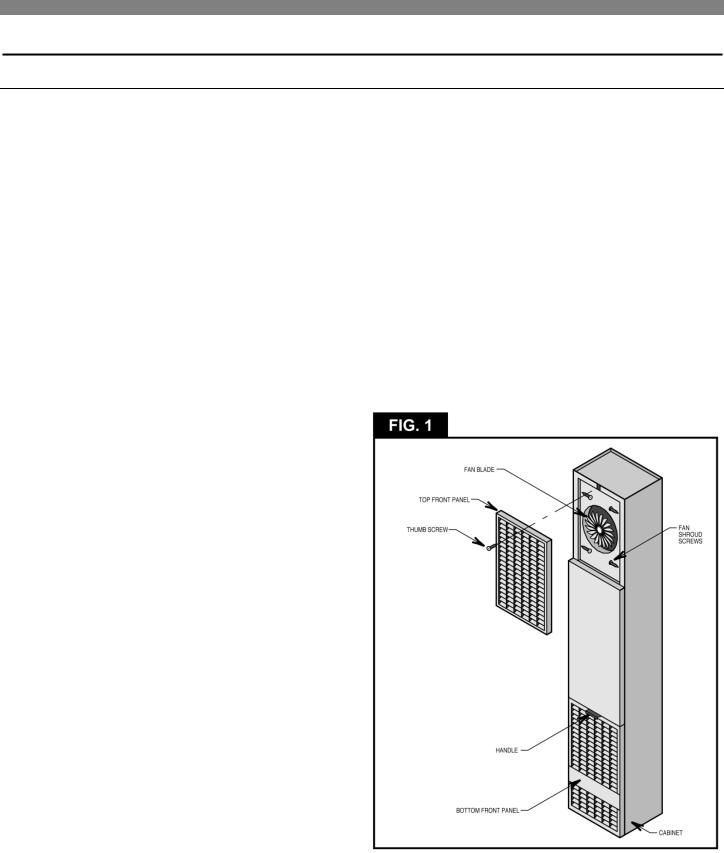
Introduction
Optional Accessories
DIFFUSER GRILLE KITS 6703 & 6704
Let’s you route some heated air in a two-way direction. Kit 6704 for one-way direction.
SIDE OUTLET GRILLE KIT 6702
Allows you to direct heated air from the side of furnace into the same room.
OUTLET GRILLE REGISTER 6701
Let’s you route some heated air into a second room. Mounts on the side wall of second room and must be within 10 inches of wall furnace.
REAR OUTLET KITS 6801 & 6802
Let’s you route some heated air into a second room behind the furnace. Finished wall of second room must be within 10 inches of furnace as shown on Page 8, Fig. D. Built-in damper lets you shut off air flow to second room if desired.
OVAL VENT KIT 9901
This U.L. listed B/W vent kit contains 4 feet of oval double walled vent pipe, plate spacers and starter or hold-down plate that starts the venting from the top of the furnace. See page 16 for additional items you will need.
VENT ENCLOSURE KITS 9812 or 9824
These kits are used only when the furnace is surface mounted. They enclose the vent pipe from the top of the surface to the ceiling.
TRIM STRIP KIT 4701
Provides finished edge at sides of wall furnace. Neutral beige enamel painted steel.
Unpack Your Furnace |
|
|
The furnace is shipped in one carton containing the furnace, |
|
|
FIGURE 1 |
|
|
installation instruction booklet and hardware bag. |
|
|
|
|
1.Lay carton horizontally. Open carton and remove top trim cover from its packing. Remove thumb screw at top of furnace, raise top front panel ½ inch and remove panel from cabinet. This is so you can get to the electrical connections later.
2.Place these and other parts, as they are removed from furnace, where they cannot be lost or damaged before you need them.
3.Bottom front panel can be removed by grasping just below handle and pulling it outward and then upward. See Fig. 1.
NOTE
Check the burner rating plate, located in burner compartment, to make sure your furnace is equipped to operate on the type of gas available (either Natural or L.P. Gas). Do NOT convert unit from Natural Gas to L.P. Gas or from L.P. Gas to Natural
4.Remove all literature and package containing thermostat, wire and metal anchors used for free standing installation.
5.Check the fan blade to be sure it spins freely.
6

Installing Your Furnace
The following steps are needed for proper installation and safe operation of your furnace. If you have any doubts as to any requirements, always consult your local Heating or Plumbing lnspector, Building Department or Gas Utility Company regarding regulations, codes, or ordinances which apply to the installation of a vented wall furnace. Obtain professional help where needed.
The CHECK AND ADJUSTMENTS on page 24 are vital to the proper and safe operation of the furnace. Be sure they are done.
IMPORTANT
For satisfactory and trouble-free operation, be sure to:
1.Locate the furnace properly within the space to be heated.
2.Install the furnace in accordance with local codes or ordinances and instructions provided. In the absence of local codes or ordinances, install the furnace to conform with the current edition of the National Fuel Gas Code, NFPA 54, ANSI Z223.1/Canadian Installation Code, CAN/CGA B149.
3.Maintain minimum clearance: Floor 0 inches or ceiling 2 inches, side wall 4 inches. For exception to minimum side wall clearance, as shown on Page 8, Fig. 3.
4. Provide |
enough |
combustion |
and |
ventilation |
air. |
Locating Wall Furnace & Thermostat
Consider the following points before attempting to install the furnace:
With standard furnace discharge outlet, do not install closer than 4 inches to intersecting wall. See figure as shown on Page 8, Fig. 3B.
CAUTION: Do not make cut-outs in the wall or ceiling before checking in the attic for ceiling joist locations and proposed venting.
The counterflow vented wall furnaces are shipped ready to install on the surface of the wall or recessed up to 9-1/4 inches into the wall, with studs 16 inches center-to-center or stud space can be framed to 16 inches, see page 11, Recessed Mounting.
Place the furnace near the center of the space to be heated for good air circulation. Do not put it behind a door or draperies.
Do not instatl the furnace in a closet, alcove, of small hallway where the furnace could be isolated by closing doors to the heater space.
Do not install the furnace in a mobile home, trailer, or recreational vehicle.
The bottom of the furnace may rest directly on a wood or concrete floor, If floor is other than wood or concrete there must be a piece of wood or sheet metal under the furnace that is at teast the same size as the bottom of the furnace.
On recessed installations the recessed portion rnay have 0 inches clearance to combustible material.
To provide adequate clearance and service access the front of the furnace must face the open room. Be sure that gas piping and electrical wiring can be brought to the location. See sections covering piping and electrical wiring for your type of furnace mounting.
Furnace vent must be installed directly to the outdoors so that combustion gases will not collect inside the building.
Provide an adequate vent or flue in accordance with local codes or ordinances and instructions provided by the vent pipe manufacturer.
Check the minimum spacing needs as shown on Page 7, Fig. 2 and Page 8, Fig. 3.
The top of the furnace must be at least 4 inches from the ceiling. See Fig. 2.
When using optional kits 6703 or 6704 maintain clearances as shown on Page 8, Fig. 3A or 3C.
When using optional kit 6704 maintain clearance as shown in Figs. 3A and 3F, page 8. Use only optional outlet and grille kits available from manufacturer.
FIGURE 2 Minimum Clearances

Installing Your Furnace
FIGURE 3 Minimum Clearances
With standard furnace discharge outlet, do not install closer than 4 inches to intersecting wall.
Choose a location for the thermostat about 5 feet above the floor on an inside wall. The thermostat wire supplied with your furnace is 20 feet long, which should be enough to run up through the attic so the thermostat can be a maximum of 16 feet from the furnace measured in a straight line, or approximately 12 feet from the furnace if the wire is run under the floor. The thermostat should be sensing average room temperature, avoid the following:
HOT SPOTS: |
COLDSPOTS: |
Concealed pipes or ducts |
Concealed pipes or ducts |
Fireplaces |
Stairwells – drafts |
Registers |
Doors – drafts |
TV sets |
Unheated rooms on |
Radios |
other side of wall |
Lamps |
|
Direct sunlight |
DEAD SPOTS |
Kitchen |
Behind doors |
|
Corners, and alcoves |
After picking a location that meets the requirements, check the walls, attic and roof to make sure there are no obstructions such as pipes, electric wiring, etc., which could interfere with the installation of the furnace or vent pipe. If required, move them or pick a new location.
WARNING: Danger of property damage, bodily injury or loss of life. Do not install furnace in any area where oxygen is in use.
Combustion & Ventilation Air
WARNING: Danger of property damage, bodily injury or loss of life. The furnace and any other fuelburning appliances must be provided with enough fresh air for proper combustion and ventilation of flue gases. Most homes will require that outside air be supplied into the heated area.
The high cost of energy for home heating has brought about new materials and methods used to construct or remodel most current homes. The improved construction and additional insulation has reduced the heat loss and made these homes much tighter around windows and doors so that infiltrated air is minimal. This creates a problem to supply combustion and ventilation air for gas-fired or other fuel burning appliances. Any use of appliances that pull air out of the house (clothes dryers, exhaust fans, fireplaces, etc.) increases this problem and appliances could be starving for air.
In addition, these energy measures mean that your home will retain more water vapor or a higher relative humidity.
High humidity, especially during cold weather, may be damaging to buildings because condensation forms on windows and inside walls.
The combination of a tight energy efficient home with the use of exhaust fans, fireplaces, clothes dryers, and gas appliances result in more and more air being drawn from the house until fresh air may be sucked back into the house down a furnace flue or fireplace chimney. Carbon monoxide can be the result. Carbon monoxide (CO) is a colorless, odorless gas produced when fuel is not burned completely or when the flame does not receive sufficient oxygen. Automobiles, charcoal, wood fires and improperly vented or air-starved coal, oil and gas furnaces or other appliances can produce carbon monoxide.
Be aware of these air-starvation signals:
1.Headaches, nausea, dizziness.
2.Excessive humidity shown by heavily frosted windows or a moist "clammy" sensation.
3.Fireplace smoke fills the room or will not draw.
4.Furnace flue backs up.
8

Installing Your Furnace
AIR REQUIREMENTS
The requirements for providing air for combustion and ventilation are listed in the National Fuel Gas Code NFPA 54/ANSI Z223.1 (in Canada: CAN/CGA B149). Most homes will require that outside air be supplied to the heated area by means of ventilation grilles or ducts connecting directly to the outside or spaces open to the outdoors such as attic or crawl space. The only exception is when the furnace area meets the requirements and definitions for an unconfined space with adequate air infiltration.
WARNING: Danger of property damage, bodily injury or loss of life. The furnace and any other fuelburning appliances must be provided with enough fresh air for proper combustion and ventilation of flue gases. Most homes will require that outside air be supplied into the heated area.
All air openings and connecting ducts must comply with the following:
If the furnace is installed in an area with another gas appliance(s), the total input rating of all appliances must be considered when determining the free area requirements for combustion and ventilation air openings.
Ducts must have the same cross-sectional area as the free area of the openings to which they connect. The minimum dimension of rectangular air ducts must not be less than 3-inches in length or height.
LOUVERS / GRILLES AND SCREENS COVERING FREE AREA OPENINGS
If a screen is used to cover the opening(s), it must not be smaller than 1/4-inch mesh. Use the free area of a louver or grille to determine the size opening required to provide the free area specified. If the free area is not known, assume a 20% free area for wood and a 60% free area for metal louvers or grilles.
EXAMPLE 1
FURNACE LOCATED IN UNCONFINED SPACE.
An unconfined space must have a volume of a minimum 50 cubic feet per 1000 Btu/hr. of total of all appliances in area. Adjoining rooms may be included only if there are no doors between the rooms, or if special provisions are made such as ventilation grilles installed between connecting rooms.
Page 10, Fig 6 shows the minimum area in square feet' based on 8 foot ceiling heights, required for different Btu/hr. input ratings.
A.If your furnace is in an open area (unconfined space*) the air that leaks through the cracks around doors and windows may be enough for combustion and ventilation air. The doors should not fit tight. The cracks around windows should not be caulked or weather stripped.
To determine if infiltration air is adequate, perform following checks:
1.Close all doors and windows. If you have a fireplace, start a fire and wait until flames are burning vigorously.
FIGURE 4 Draft Hood Spillage
2. |
Turn on all exhausting devices, such as: |
|
|||
|
kitchen |
and |
bathroom |
exhaust |
fans |
|
dryers (gas and electric) |
|
|
||
3. |
Turn on |
all vented gas appliances, such as: |
|||
|
heating |
equipment |
including |
any room |
heaters, |
water heater/stoves.
4.Wait ten (10) minutes for drafts to stabilize.
5.Check for draft hood spillage at each appliance. (Hold a lighted match 2 inches from draft opening. See Fig. 4.)
B.No Spillage
If the match flame pulls toward draft hood - this indicates sufficient infiltration air:
1.Return exhausting devices and appliances to the condition you found them.
C.Draft Hood Spills
If there is spillage at a draft hood (match goes out or flame wavers away from draft hood):
1.Check for plugged flue connectors and chimneys. Check and repair, stoppage and test again.
2.If you have a fireplace, open a window or door near the fireplace and then check for spillage.
a)If spillage stops, do not use the fireplace without a nearby window or door open until you can supply fresh air by a permanent duct.
3.If you have kitchen and bathroom exhaust fans, turn them off and check for spillage.
a)If spillage stops, do not use exhaust fans until you can supply fresh air by a permanent duct.
WARNING: Danger of property damage, bodily injury or loss of life. Draft hood spillage, with unobstructed vents, indicates that additional air must be brought into the structure from outside. Keep a window open (minimum 2 inches) near the appliance until a permanent air duct is installed.
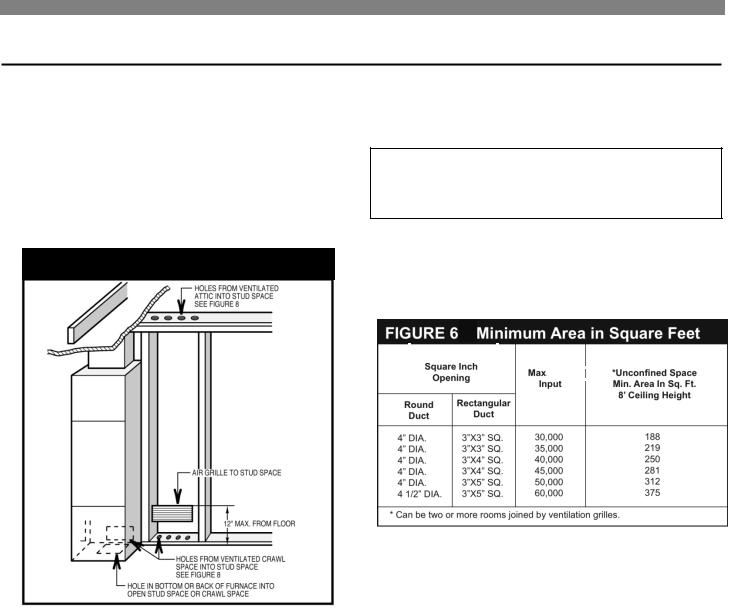
Installing Your Furnace
4.Spillage means air starvation and a fresh air duct or air intakes must be installed to provide air directly to the furnace or other gas appliance.
D.If spillage exists or when the furnace is in a building of tight construction where the windows and doors are weatherstripped, air for combustion and ventilation must be obtained from outdoors or space open to the outdoors.
Provide an opening(s) having a total free area of 1-square inch per 4000 Btu/hr. for the total of all appliances. The required area is shown on page 11, Fig. 9.
FIGURE 5 Fresh Air duct
Fig 5 shows a typical duct going into ventilated crawl space or attic.
1.Duct must terminate at a point not more than 1 foot above the floor.
2.Duct size must be at least 1 inch of free area for each 4000 Btu/hr. of input of all appliances in area.
EXAMPLE 2.
FURNACE LOCATED IN CONFINED SPACE.
If furnace is installed in a confined space, it must be provided with free air for proper combustion and ventilation of flue gases by one of the following methods.
A.All Air From Inside Building:
If the confined space adjoins an unconfined space, provide two permanent openings, one within 12 inches of the top and one
10
within 12 inches of the bottom of the room connecting directly to unconfined space. Each opening must have a free area of at least 100 square inches or 1 square inch per 1000 Btu/hr. combined input of appliances in one room if combined input exceeds 100,000 Btu/hr.
WARNING: Danger of property damage, bodily injury or loss of life. The adjoining unconfined space must have adequate air infiltration as defined in example 1.
FOR EXAMPLE: Your furnace is rated at 50,000 Btu/hr. The water heater is rated at 30,000 Btu/hr. The total is 80,000 Btu/hr. You need two grilles, each with 100 square inches of free opening. Metal grilles have about 60% free area, so you need two metal grilles each with 160 square inches of louvered area.
4,000 Btu/hr. Per
Btu/hr. |
Refer to figure as shown on Page 11, Fig. 7, which shows grille installation. Using the previous example, the two connecting rooms plus the closet must equal at least 500 sq. feet to handle the combined input 50,000 plus 30,000.
B.All Air From Outdoors:
If confined space doesn't adjoin an unconfined space then air must be provided from outdoors or spaces open to outdoors such as attic or crawl space.
Provide two permanent openings, one within 12 inches of top, one within 12 inches of bottom of room connecting directly, or by using ducts, with the outdoors or areas open to outdoors.
If opening connects directly to, or within vertical ducts, the free area of each opening must be at least 1 square inch per 4,000 Btu/hr. combined input of appliances in area.
If horizontal ducts are used, the free area of each opening must be at least 1 square inch per 2,000 Btu/hr. combined input of appliances in area.
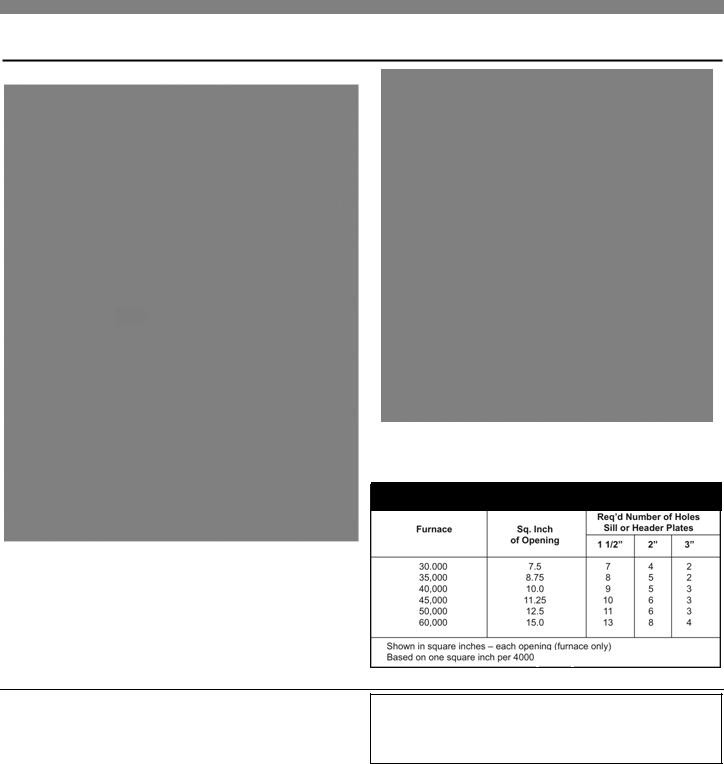
Installing Your Furnace
FIGURE 7 Grilles Connecting Rooms to |
|
FIGURE 8 Air from Outdoors or Crawl |
Make Unconfined space |
|
Space |
FOR EXAMPLE: Your furnace is rated at 50,000 Btu/hr. The water heater is rated at 30,000 Btu/hr. The total is 80,000 Btu/hr. You need two grilles, each with 20-square inches of free opening, unless connected by horizontal ducts which would require each grille or opening to have a free area of 40 square inches.
Openings for inlet or outlet air should not be made into attic area if attic is equipped with a thermostat controlled power vent.
FIGURE 9 Free Area
Btu/hr./Input |
Btu/hr. |
Recessed Mount Installation
FIND THE STUDS (See CAUTION on page 7)
Use a stud locator or small finishing nails. Repeatedly drive and remove a nail into the wall in the area of the stud until it is located. Then find the inside edge of the stud. Leave the nail at this location.
The other stud should be about 14½-inches from the one found. Drive finishing nails on the inside of this stud. Draw wall cutout to required size as shown on Page 13, Fig. 13. If wall studs are not on 16-inch centers see "CLOSE OFF STUD SPACE.” (As shown on Page 13, Fig. 12).
CUT WALL OPENING
Provide an opening as shown on Page 12, Fig. 10. Work from the top in the attic to cut away the ceiling plate.
WARNING: BEFORE INSTALLING: To avoid electrical shock, turn off electrical circuits that pass through the wall where you are going to install the furnace.
ATTACH HEADER PLATE
MODELS: 5508231; 5508232; 6508631; 6508632
Locate header plate between wall studs at 88½-inches from finished floor and nail into position with end flanges pointing up. Make sure header plate is level.
MODELS: 5008631; 5008632
Locate header plate between wall studs at 82½-inches from finished floor and nail into position with end flanges pointing up.
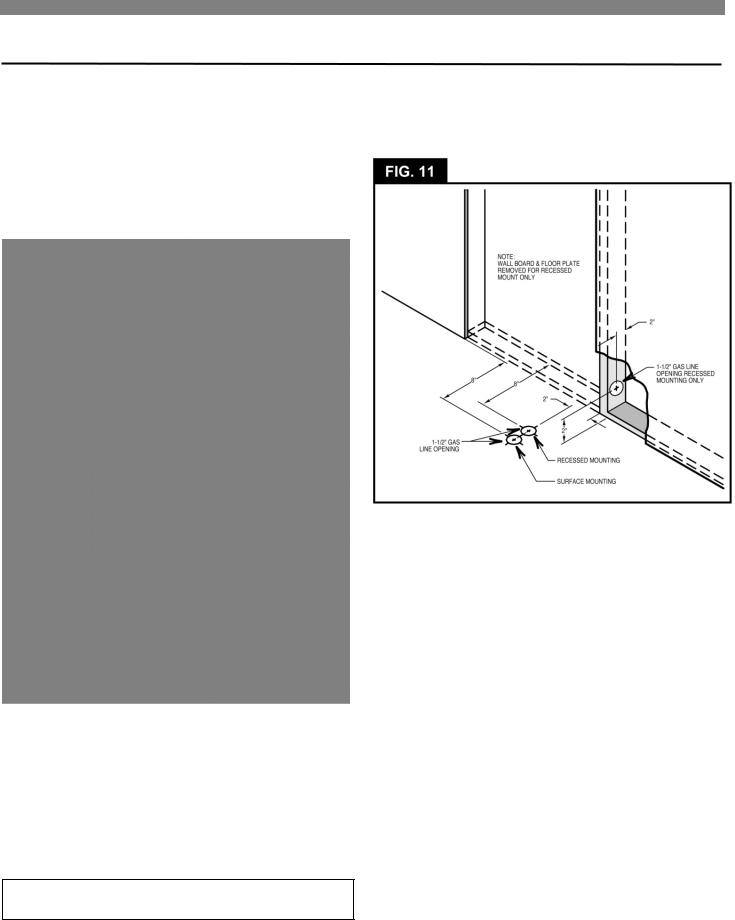
Installing Your Furnace
MODELS: 3508231; 3508232; 3508631; 3508632
Locate header plate between wall studs at 74 inches from finished floor and nail into position with end flanges pointing up.
Locate and drill one (1) 1-1/2 inch hole at selected locations as shown on Page 12, Fig. 11 and Page 13, Fig. 13 or Page 14, Fig. 14.
Gas line can be run at this time or done after furnace is mounted, see section GAS SUPPLY AND PIPING, page 18.
|
WARNING: Remove 4”x14” fiberglass gasket from |
|
FIGURE 11 |
|
|
bottom of header plate and discard. This gasket is |
|
|
|
|
not used when the furnace is recessed in the wall. |
|
|
|
|
|
|
|
|
|
FIGURE 10 |
|
|
|
|
|
|
|
|
CLOSE OFF STUD SPACE (If Required)
If studs are not on 16 inch centers, cut the hole for the furnace next to an existing stud and frame in the other side using a 2 x 4 and spacer blocks as required. As shown on Page 13, Fig. 12.
ELECTRICAL SUPPLY ROUGH-IN
Run the electrical supply with the ground wire and thermostat cable into stud space next to furnace location.
GAS SUPPLY OPENING
A hole must be drilled for the gas line supply.
Decide whether the gas line will come through the floor or wall stud.
NOTE
If a pre-existing gas piping stub location is not compatible with hole or knock-out provided in furnace, you may make an alternate entry hole in the furnace back wall as shown on Page 14, Fig. 14.
CAUTION: Be careful not to damage any furnace components while making any alternate hole.
12

Installing Your Furnace
FIGURE 12 Closed Off Stud Space (If |
|
|
|
FIGURE 13 Knockout Dimensions |
|
Required) |
|
|
|
CAUTION: Do not run wire behind flanges of header plate or in any location where it might be damaged. Avoid splicing thermostat wire unless the spliced wires are properly cleaned, soldered and taped.
(1)MODELS : 5508231; 5508232
6508631; 6508632
(2)MODELS : 5008631; 5008632
(3)MODELS : 3508231; 3508232
3508631; 3508632
Surface Mount Installation
FIND THE STUDS AND CEILING JOISTS (See CAUTION on page 7)
Find two studs at spot where furnace is to be placed. Use a stud indicator or small finishing nails. Repeatedly drive and remove a nail into the wall in the area of the stud until you find it. Then find one side. Leave the nail there. Drive another nail just on the other side of the same stud.
Inside edge of the other stud should be about 14-1/2 inches from the one found. Drive finishing nail on inside edge of this stud.
Using the nails as a guide, draw a line up both sides to the ceiling to locate hole cut out for vent pipe and electrical connections.
CUT CEILING OPENING
Mark off and cut 3-1/2 x 12 inch rectangular hole in ceiling, centered between wall studs. The back edge of the opening should be about 1/8 inch from the wall. As shown on Page 15, Fig. 16.
ELECTRICAL SUPPLY ROUGH-IN
The electrical supply openings must be made in the wall or floor below furnace to match holes in furnace bottom. See Fig. 13.
If desired, the power supply and thermostat cable can come into the wall stud space from a basement, crawl space or an adjoining stud space.
At selected location, drill a 1-inch hole for 115V power supply and a ½ inch hole for the thermostat cable.
Run wiring through the holes to the furnace leaving enough excess wire to make electrical connections after mounting furnace.
CAUTION: To avoid damage to wiring, be sure to route wire away from path of furnace vent.
GAS SUPPLY OPENING
A hole may need to be drilled for the gas line supply.
Decide whether the gas line will come through the floor or wall.
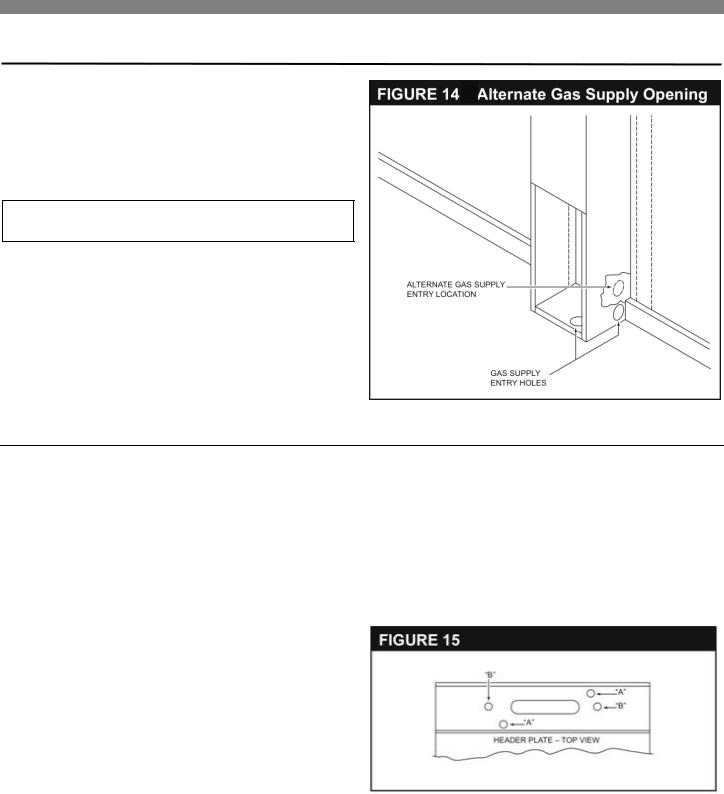
Installing Your Furnace
NOTE
If you decide to route gas line through right side of furnace, simply remove the knock-out provided in furnace side.
NOTES
If a pre-existing gas piping stub location is not compatible with hole or knock-out provided in furnace, you may make an alternate entry hole in furnace back wall per Fig. 14.
CAUTION: Be careful not to damage any furnace components while making any alternate hole.
Locate and drill one (1) 1-1/2 inch hole at selected location as shown on Page 12, Fig. 11; Page 13, Fig. 13, or Page 14, Fig 14.
Gas line can be run at this time or done after the furnace is mounted, see section CONNECTING GAS LINE.
General Vent Installation
The vent installation must comply with all local codes and ordinances. If in doubt, consult your local codes or inspector.
The furnace vent must be directed to the outdoors so that harmful combustion gases will not collect inside the building.
This furnace must not be connected to a chimney flue serving a separate solid-fuel burning appliance.
Use U.L. listed B/W Vent Kit 9901. You must provide other items, not contained in the kit, necessary to complete your specific venting situation through the roof. Refer to typical venting system as shown on Page 16, Fig. 18.
Type B/W gas vent shall extend from the header plate of the vented wall furnace to a point above the highest ceiling plate within a stud space through which the vent passes, without any offsets or crossovers therein. After a type B/W gas vent passes through the highest ceiling plate within a stud space above the furnace which it serves, the vent system may be completed with a type B vent, of the same manufacturer, and offsets or break over, shall not be greater than 45 degrees from vertical. Maximum of two.
NOTE
The B/W vent must extend through the ceiling and roof terminating at least 12 feet above the finished floor on which the furnace rests.
ATTACH HEADER & HOLD-DOWN PLATE (SURFACE MOUNT)
Remove the fiberglass flue collar from the furnace flue extension. This gasket is not used when the furnace is surface mounted.
Make sure that the 4 x 4 inch gasket is in position on the header plate.
Slide header plate over the furnace flue extension with the junction box entering the opening in top of furnace.
Refer to Fig. 15.
Fasten to matching holes in the furnace top through holes "A" in the header plate, using two (2) #8 x 3/8 inch screws provided.
First vent pipe offset (if required) is recommended not to be any closer than 2'-0" from header plate.
Fasten the hold-down plate or starter plate to the top of the header plate using holes "B" in the header plate.
14
